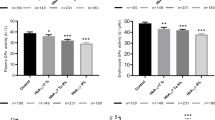Abstract
Hyperglycemia and dyslipidemia in diabetes mellitus induce increased lipid peroxidation and peroxyl radical formation, an important mechanism in genesis of microangiopathy. We took up a study on oxidative stress, measured by plasma MDA and antioxidant vitamin status in type − 2 DM patients with and without retinopathy and compared them with a control non-diabetic group. Lipid peroxidation marker MDA was significantly elevated (p < 0.001) in both the diabetic groups whereas, serum vitamin E and vitamin C registered a significant fall (p<0.001) as compared to controls. Our correlation study revealed a significant positive association between plasma MDA with both fasting and 2hr post prandial plasma glucose (r=0.81, p < 0.001, r=0.92, p <0.001) suggesting the role of hyperglycemia in free radical production. Plasma MDA also depicted significant positive relation (p< 0.001) with all lipid parameters except serum HDLc pointing the role of dyslipidemia towards lipid peroxidation. Plasma MDA level was also found to be negatively correlated with both the vitamins (p<0.001, p<0.001) in the study group explaining their protective consumption in the oxidative process prevailing in diabetic retinopathy.
Similar content being viewed by others
References
Sulochana KN, Ramakrishnan S, Rajesh M, Coral K, Badrinath SS. Diabetic retinopathy: Molecular mechanisms, present regime of treatment and future perspectives. Current Science 2001;80(2):25.
Ohira A, de Juan E Jr. Characterisation of glial involvement in proliferative diabetic retinopathy. Opthalmologica 1990;201:187–195.
Wolff SP, Dean RT. Glucose autooxidation and protein modification. Potential role of “auto-oxidative glycosylation”in diabetes.Biochem J1987;245:245–250.
Ceriello A, Giugliano D, Quatraro A, Donzella C, Dipalo G, Lefebvre. Vitamin E reduction of protein glycosylation in diabetes. Diabetes Care 1991; 14(1):68–72.
Davie SJ, Gould BJ, Yudkin JS. Effect of vitamin C on glycosylation of proteins. Diabetes1992; 41:167–173.
Gupta MM, Chari S. Lipid peroxidation and antioxidant status in patients with diabetic retinopathy. Ind J Physiol Pharmacol 2005; 49(2):187–192.
Diabetes Mellitus reports of WHO study group. Tech Rep Ser 1985; 727:1–113.
Trinder P. Determination of glucose using glucose oxidase with an alternative oxygen acceptor. Ann Clin Biochem 1969;6:24–27.
Flegg HM. An investigaion of the determination of serum cholesterol by an enzymatic method. Ann Clin Biochem 1973;10:70–84.
Burstein M, Scholnick HR, Morfin R. Rapid method for isolation of lipoprotiens from human serum by precipitation with polyanion. J Lipid Res1970;11:583–595.
Friedewald WT, Levy R, Fredrickson DS. Estimation of the concentration of low density lipoprotein cholesterol in plasma without use of the preparative ultracentrifuge. Clin Chem 1972;18:499–502.
Fossati P, Prenciple L. Serum triglycerides determined colorimetrically with an enzyme that produces hydrogen peroxide, Clin Chem 1982;28:2077–2080.
Satoh K. Serum lipid Peroxide in cerebrovascular disorders determined by a new colorimetric method. Clin Chem Acta 1978;90: 37–43.
Lowry OH, Lopez JA, Bessey OA. The determination of ascorbic acid in small amounts of blood serum. J Biol Chem 1945;160:609.
Baker H, Frank O. Clinical Vitaminology, 1968; New york; Wiley; 172.
Bakker SJ, Ijzerman RG, Teerclink T. Cytosolic TAG & oxidative stress in central obesity, the missing link between excessive atherosclerosis, endothelial dysfunction and beta cell failure? Atherosclerosis 2000; 148: 17–21.
Gotto AM Jr. Triglyceride as a risks factors for coronary artery disease. Am J Cardiol 1998; 82: 22–25.
Procter H, Reynolds ES. Free radicals and disease in man. Physiol Chem Phys 1984;16: 175–95.
Beatty S, Koh H, Phil M, Henson D, Boulton M. The role of oxidative stress in the pathogenesis of age related macular degeneration. Surv Ophthalmol 2000; 45(2): 115–134.
Author information
Authors and Affiliations
Corresponding author
Rights and permissions
About this article
Cite this article
Kumari, S., Panda, S., Mangaraj, M. et al. Plasma MDA and antioxidant vitamins in diabetic retinopathy. Indian J Clin Biochem 23, 158–162 (2008). https://doi.org/10.1007/s12291-008-0035-1
Published:
Issue Date:
DOI: https://doi.org/10.1007/s12291-008-0035-1




